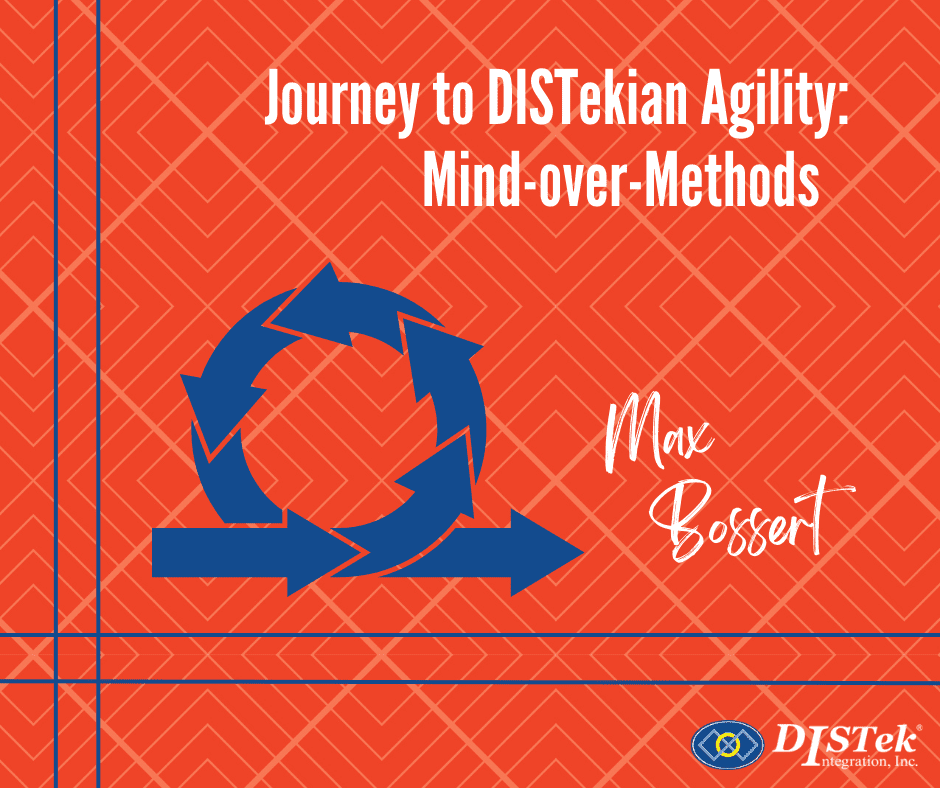At DISTek, we pride ourselves on the ability to remain adaptable. We make it a priority to listen and are quick to adapt to the processes, tools, and approaches of our clients. Transparent communication is a top priority, and our goal is always to operate as a seamless extension of our clients’ team.
When our client doesn’t have a process in place that they’d like us to use, we quickly recommend using Agile principles, which we currently utilize across most of our project teams. We firmly believe that the benefits of this approach are many in number, but specifically, it offers the ability for our engineers to work collaboratively with our client to further refine project definition during development and handle adjustments to project direction as discoveries are made.
DISTek Test Engineer, Max Bossert, shares his personal journey with Agile below:
I remember the first two weeks of my initial project at DISTek quite vividly. With only a few hours of training on the Hardware In the Loop (HIL) system, I struggled to get the electronic control unit (ECU) online. I waited patiently for the client’s team manager to come and lay out all the testing activities that they needed. This never happened. Eventually, I got the ECU online and started making contributions to the HIL test team. I felt like I was part of the team and finally had my two legs under me. Taking charge of the full testing process proved to be a mountainous task as one-man team. I struggled to jump between requirement writing and testing. Each week felt like I was making little to no progress. At this point in my career, I had not learned about Agile and was approaching the project with my college-learned, waterfall approach. Constantly shifting business objectives caused the target to seem unreachable. To relieve my anxiety around this lack of progress, I directed my focus to leaning into the DISTek Values. More specifically, I focused on my Can-Do Attitude and Serving with Excellence as primary value producers during my spin-up time in this role. Although these values helped me better add value to the project, I still felt a lack of efficiency in the process.

The culmination of all these deficiencies resulted in my search for a better day-to-day workflow. I remember continuously switching back and forth between OneNote and handwritten notes in the pursuit of creating traceability. I thought creating traceability, or a procedural/mechanical workflow would heighten my productivity and efficiency. Although the client used several common Agile tools, I was not using them in an Agile way. After reaching out to DISTek for help with our workflow definition, a fellow employee-owner guided us to produce value more efficiently for our client. He pointed us back to the Agile principles and the manifesto before explaining how to use these concepts in our everyday decision making. Another action he suggested included reading The Journey to Enterprise Agility. He detailed that the book provides all the tools to aid in creating an Agile mindset. Upon reviewing the manifesto and principles, our team decided that we needed to clarify the project description with the client. To accomplish this, we identified the business value the client wanted us to accomplish through the projects. This meant we identified value stories. A value story, as described by The Journey to Enterprise Agility, is a way you connect value to the work you do. Identifying and incorporating value stories shifted my mindset. My understanding of Agile has shifted from a tool we generate structure/organization with, to a tool that permeates our mindset. This shift empowered me to make more decisions that fully align with the guiding agile principles.
After I wrapped up work with that client, I shifted over to work on our internal team. This team is a landing place for any DISTekian between projects, where they can complete internal initiatives, implement processes for increased efficiency, and expand their knowledge set and hone new skills. I began reading The Journey to Enterprise Agility and took a Udemy course on Agile Software Engineering Fundamentals. Many of the issues that I had experienced with my previous client were expertly described as symptoms of a failing workflow. Even though I could now identify what had gone wrong, I could not explain how to fix it. Agile proved difficult to understand, since it is not a static generic workflow. Agile is better explained as the means to finding an emergent workflow. Function is form, as preached in biology, thus, to build a dynamic team for a unique project we must incorporate emergent architecture. This form of workflow architecture formation is guided through the Agile principles, meaning that each decision is directly influenced by weighing the Agile principles. This weighing of the principles allows Agile to stretch and contract where needed, generating a custom-fit workflow for the team.
Circling back to my actual work on our internal team, I have been helping form the initial structure of our team through the requirements stated by our business plans. This opportunity has provided me with the testbed that I needed to see Agile working in action. I have found that much of the architecture emerges from the discussions about the projects that we are currently involved in. My observation has transitioned my thinking of Agile as a ready-to-ship workflow to a mindset that provides tools to construct a workflow. I believe that once you incorporate Agile at the team level, you enable your team to work as a system to efficiently compute problems and add business value. As I continue my journey at DISTek, I will look for opportunities to utilize what I have learned about Agile to bring value not only to myself, but to my project team and client as well.


